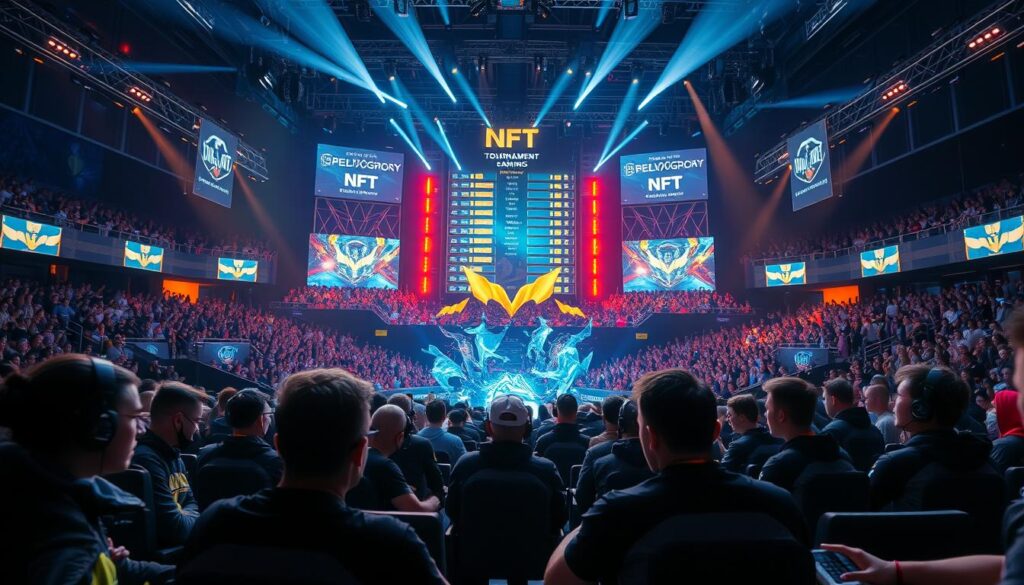Now Reading: Discover the Ultimate NFT Flipping Tools
- 01
Discover the Ultimate NFT Flipping Tools
Discover the Ultimate NFT Flipping Tools

The digital economy continues to evolve, creating fresh opportunities for savvy investors. While trading volumes have cooled since 2021, the market for unique digital assets remains robust. Analysts project its value to nearly quadruple by 2026, proving these collectibles aren’t just a passing trend.
Unlike traditional investments, this strategy focuses on short-term profit generation through strategic buying and selling. Success hinges on three pillars: understanding market patterns, precise timing, and access to specialized resources. Though some view it as risky speculation, informed participants consistently find opportunities in shifting trends.
Current data reveals a $20 billion+ valuation for the space, with platforms hosting thousands of daily transactions. While initial hype has faded, serious traders recognize the staying power of verified collections and emerging projects. This guide will break down proven methods to navigate this dynamic landscape effectively.
Key Takeaways
- Digital asset trading remains profitable despite market fluctuations
- Strategic timing separates successful traders from casual participants
- Specialized platforms provide critical market insights for informed decisions
- Verification and research prevent costly mistakes in fast-moving markets
- New tools streamline the process of identifying undervalued opportunities
Understanding the Fundamentals of NFT Flipping
The rise of blockchain technology has introduced new methods for generating short-term gains. Unlike traditional investments, this strategy focuses on acquiring unique digital items and reselling them rapidly. Its growing popularity stems from accessibility and the ability to trade globally without physical limitations.
What Exactly Is NFT Flipping?
This practice involves purchasing blockchain-based tokens at lower prices and selling them quickly for profit. These tokens represent ownership of items ranging from digital art to tokenized real estate. Each transaction leaves a permanent record on the blockchain, ensuring transparency.
Three factors differentiate this approach:
- Immediate profit focus vs long-term holding
- 24/7 global market access
- Lower capital requirements than physical asset trading
Key Benefits and Risks
Successful traders enjoy rapid returns and exposure to innovative projects. However, challenges include:
- Sudden price swings in speculative markets
- Potential counterfeit listings on unverified platforms
- Limited buyers for niche collections
Smart investors mitigate risks by researching project teams and tracking transaction histories. While profits can be significant, treating this as a skill-based activity yields better results than relying on luck.
Navigating the Dynamic NFT Market Landscape
Market cycles in the digital collectibles space follow patterns similar to traditional investments. Weekly trading volume charts reveal critical insights for identifying opportunities. Savvy traders track these metrics to spot emerging trends before they peak.

Market Trends and Trading Volumes
Bullish phases show rising sales activity across platforms, while bear markets see prolonged dips. Three indicators help gauge current conditions:
- 30-day average transaction counts
- Platform-specific bid/ask ratios
- Google Trends data for related search terms
Digital art collections often lead market recoveries, followed by tokenized real estate and gaming assets. Cross-referencing this data with broader cryptocurrency movements improves prediction accuracy.
Timing Your Entry and Exit
Optimal buying windows emerge when:
- Daily volumes drop below 6-month averages
- Social media chatter declines sharply
- New project launches slow temporarily
High liquidity periods typically last 2-3 weeks during upward trends. Track whale wallets through blockchain explorers to spot early accumulation patterns. Celebrity endorsements and regulatory updates can abruptly shift market sentiment, creating urgent selling opportunities.
Essential NFT Flipping Tools for Success
Selecting the proper resources separates profitable traders from casual participants in the digital collectibles space. Specialized software enhances user experience by streamlining market analysis and minimizing costly errors. Savvy traders combine multiple platforms to create competitive advantages in fast-moving markets.
Importance of the Right Tools
Three platforms demonstrate how technology enhances decision-making. BitDegree offers collection analytics, tracking historical performance and community engagement. Moby delivers real-time sales data across marketplaces, highlighting emerging trends. Rarity.tools assesses asset uniqueness through scoring algorithms, helping traders spot undervalued pieces.
Effective strategies blend free and premium services. Basic versions suit beginners, while advanced features justify subscription costs for active traders. Key integration approaches include:
- Combining rarity scanners with portfolio trackers
- Syncing alerts across multiple devices
- Exporting data into customized dashboards
Regularly evaluating new solutions prevents technological obsolescence. Successful traders allocate 20% of their research time to testing innovative features while maintaining core workflows. This balance ensures adaptability without compromising proven methods.
Strategies for Successful Buying and Selling of NFTs
Mastering market dynamics requires a blend of analytical rigor and behavioral insight. Savvy traders focus on two critical metrics: liquidity thresholds and baseline valuations. These indicators help identify projects with realistic profit potential while avoiding overhyped collections.

Analyzing Market Liquidity and Floor Prices
Baseline valuations represent the minimum entry point for any collection. Projects with stable minimums and active trading histories often provide safer opportunities. Three factors determine resale potential:
- Daily transaction volume exceeding 50 ETH
- Consistent 7-day buyer activity
- Less than 15% spread between bids and asks
Prioritize collections where 80% of items trade above baseline. This signals strong demand and reduces exposure to sudden price crashes.
Utilizing Psychological Pricing
Human perception heavily influences purchase decisions. Pricing assets at 0.99 ETH instead of 1.0 creates an illusion of value, boosting conversion rates by up to 17%. Other effective tactics include:
- Listing multiples of 3 (e.g., 3.33 ETH)
- Using round numbers for premium items
- Mirroring successful competitors’ pricing patterns
Track sales velocity after adjustments. Assets lingering beyond 72 hours typically need repricing or enhanced promotion. Combine these techniques with stop-loss orders at 20% below purchase price to lock in gains and minimize losses.
Identifying High-Value NFT Projects
Spotting valuable opportunities in the digital collectibles space requires sharp evaluation skills. Three pillars determine long-term potential: scarcity, real-world benefits, and trustworthy creators. Let’s break down how to separate promising ventures from risky bets.
Assessing Rarity, Utility, and Team Credibility
Scarcity drives demand. Collections with limited editions under 1,000 items often hold their value better than mass-produced ones. Check minting histories on blockchain explorers to verify actual supply numbers.
Real-world utility transforms simple tokens into sought-after assets. Look for projects offering:
- Exclusive event access
- Physical product discounts
- Voting rights in community decisions
Anonymous teams should raise immediate red flags. Research creators’ LinkedIn profiles and past work. Successful projects usually have:
- Public team members with verifiable credentials
- Clear roadmaps updated quarterly
- Active social media engagement
Art quality remains critical in the non-fungible token space. Collections blending unique styles with cultural relevance tend to outperform generic designs. Analyze community forums for genuine collector reactions rather than paid promotions.
Always cross-check intellectual property rights before investing. Projects using unlicensed characters or logos often face legal challenges that crater their value overnight.
Effective Pricing and Listing Techniques
Mastering pricing strategies transforms digital collectibles into profitable sales. Successful sellers balance market trends with platform-specific costs to maximize returns. Let’s explore methods to position your items effectively.

Setting Competitive Prices
Research floor prices across platforms before listing. Compare recent sales of similar items using blockchain explorers. Three tactics boost visibility:
- Price assets 5-10% below current market averages
- Use decimal pricing (e.g., 0.89 ETH instead of 0.9)
- Highlight unique attributes in listings
Monitor competitor adjustments daily. Items priced between 0.1-1 ETH typically sell fastest. For rare pieces, consider auctions starting at 50% of estimated value to spark bidding wars.
Managing Marketplace Fees
Platform costs vary significantly. OpenSea charges 2.5% per sale, while Rarible takes 5%. Always calculate:
- Listing fee (if applicable)
- Transaction percentage
- Gas costs for blockchain confirmation
Build these expenses into your minimum price target. Cross-list identical items on multiple platforms, but avoid undercutting your own prices. Use auto-repricing tools to adjust listings based on market shifts without manual oversight.
Leveraging NFT Marketplaces for Enhanced Liquidity
Choosing the right platform dramatically impacts your ability to execute fast trades. Major exchanges offer distinct advantages depending on your strategy and collection type.
Comparing Leading Trading Platforms
OpenSea dominates with $5 billion+ monthly volume and 1 million+ assets. Its 2.5% fee structure attracts serious collectors, though competition for visibility remains fierce. Key benefits include:
- Instant access to trending collections
- Advanced filtering for rarity traits
- Integrated wallet tracking tools
Rarible supports Ethereum, Flow, and Tezos blockchains – ideal for cross-chain strategies. While its $1.56 million monthly volume pales next to OpenSea, emerging artists often debut here first. Traders appreciate:
- Lower initial minting costs
- Community governance features
- Curated drops for early access
Niche platforms like Foundation excel for high-end digital art, while exploring specialized platforms can uncover undervalued categories. Multi-listing tools help maintain price consistency across exchanges without manual updates.
Build credibility by completing verification badges and maintaining response rates above 90%. Platforms prioritize active sellers in search rankings, directly impacting sales velocity. Track trending algorithms to time listings with peak buyer activity cycles.
Integrating Automated Tools and Bots into Your Strategy
Automation reshapes how traders interact with digital asset markets. Advanced systems now handle repetitive tasks while maintaining strategic oversight. This approach lets users focus on high-value decisions rather than manual processes.
Streamlining Operations with Bots
Specialized software like Snipers.xyz tracks real-time price shifts across multiple platforms. These tools can:
- Execute purchases during overnight price dips
- Monitor rare asset listings 24/7
- Auto-adjust bids based on market momentum
Savvy traders save 15+ hours weekly by automating data collection. This extra time fuels deeper analysis of emerging non-fungible token projects.
Protecting Automated Systems
Residential proxies from providers like Bright Data mask bot activity. They prevent IP bans by:
- Rotating digital footprints hourly
- Mimicking human browsing patterns
- Maintaining multiple geographic entry points
Combined with two-factor authentication, this creates robust security layers. Proper setup ensures uninterrupted access during critical trading windows.
FAQ
How does NFT flipping differ from traditional real estate or stock trading?
Unlike physical assets, digital art and collectibles rely on blockchain verification and community-driven value. Success depends on understanding trends, digital scarcity, and platform dynamics rather than physical location or company fundamentals.
What role do floor prices play in buying and selling strategies?
Floor prices represent the lowest listed price for items in a collection. Tracking them helps identify entry points, gauge demand, and spot undervalued assets before market shifts. Tools like OpenSea’s analytics dashboard simplify this process.
Can psychological pricing tactics improve sales on platforms like Rarible?
Yes. Listing items at prices ending in .99 or slightly below round numbers (e.g., 0.99 ETH instead of 1 ETH) can attract attention. This strategy leverages perceived affordability, often increasing buyer engagement.
Why is team credibility critical when evaluating high-value projects?
Established creators with transparent roadmaps reduce risks. For example, projects like Bored Ape Yacht Club gained traction due to proven teams and consistent community engagement, which drives long-term demand.
How do marketplace fees impact profit margins?
Platforms like Foundation charge up to 15% per transaction. Factoring these costs into pricing ensures you retain desired profits. Comparing fees across marketplaces helps optimize listing decisions.
What advantages do automated bots offer for time-sensitive trades?
Bots monitor real-time price shifts, execute instant buys/sells, and track rare drops. Pairing them with residential proxies (like those from Bright Data) avoids IP bans, ensuring uninterrupted access during peak activity.
How does scarcity influence the value of digital art collections?
Limited editions or unique traits boost desirability. For instance, CryptoPunks with rare attributes sell for millions. Tools like Rarity Sniper help quantify scarcity, guiding smarter bids.
What risks come with relying solely on historical trading volumes?
Past performance doesn’t guarantee future results. Sudden hype shifts or new competitors can drain liquidity. Diversifying across collections and staying updated via platforms like Dune Analytics mitigates this.













